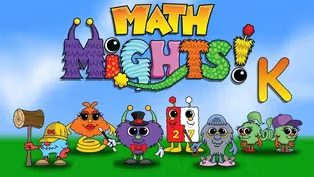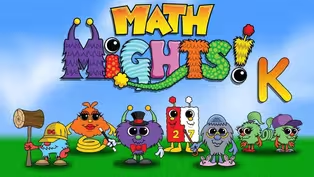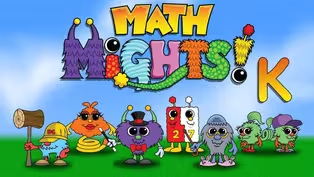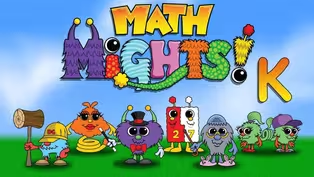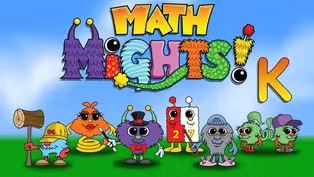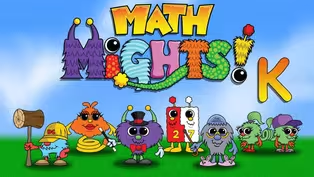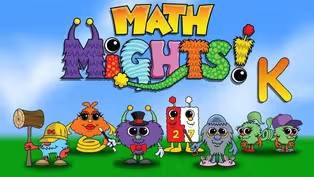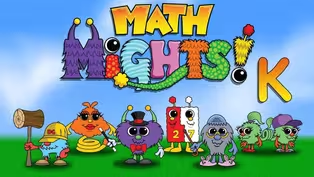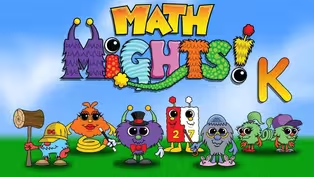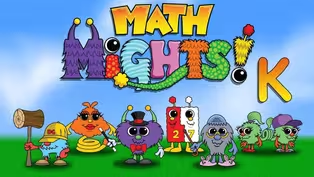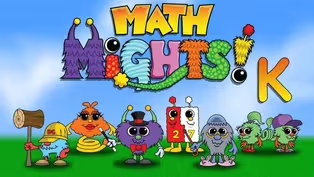Math Mights
Addition & Subtraction Expressions
Season 3 Episode 301 | 16m 15sVideo has Closed Captions
Match fun story problems with the correct addition or subtraction expression.
Join Mrs. Gray for number talk with the Counting Buddy Junior. Then get ready to match fun story problems with the correct addition or subtraction expression!
Problems playing video? | Closed Captioning Feedback
Problems playing video? | Closed Captioning Feedback
Math Mights is a local public television program presented by Detroit PBS
Math Mights
Addition & Subtraction Expressions
Season 3 Episode 301 | 16m 15sVideo has Closed Captions
Join Mrs. Gray for number talk with the Counting Buddy Junior. Then get ready to match fun story problems with the correct addition or subtraction expression!
Problems playing video? | Closed Captioning Feedback
How to Watch Math Mights
Math Mights is available to stream on pbs.org and the free PBS App, available on iPhone, Apple TV, Android TV, Android smartphones, Amazon Fire TV, Amazon Fire Tablet, Roku, Samsung Smart TV, and Vizio.
Providing Support for PBS.org
Learn Moreabout PBS online sponsorshipMore from This Collection
Video has Closed Captions
Join Mrs. Gray for a subtraction word problem with Porfessor Barble! (15m 52s)
Video has Closed Captions
Join Mrs. Gray for a subtraction word problem with Porfessor Barble! (15m 59s)
Video has Closed Captions
Join Mrs. Gray for a subtraction word problem with Professor Barble! (15m 59s)
Video has Closed Captions
Join Mrs. Gray for a subtraction word problem with Professor Barble! (15m 59s)
Compose & Decompose Numbers to 9
Video has Closed Captions
Join Mrs. Gray for a word problem with Professor Barble! (16m 1s)
Break apart pattern block designs
Video has Closed Captions
Join Mrs. Gray for a word problem with Professor Barble! (15m 59s)
Video has Closed Captions
Join Mrs. Gray for a word problem with Professor Barble! (15m 59s)
Video has Closed Captions
Join Mrs. Gray for a word problem with Professor Barble! (15m 59s)
Subtraction with Word Problems Part 2
Video has Closed Captions
Join Mrs. Gray & Dotson for a Numeracy Talk with My Counting Buddy Junior! (16m)
Video has Closed Captions
Join Mrs. Gray & Dotson to talk about numbers with My Counting Buddy Junior! (16m)
Addition Word Problems with Quick Draws
Video has Closed Captions
Join Mrs. Gray for Numeracy Talk with Dotson working on conservation to 10. (16m)
Providing Support for PBS.org
Learn Moreabout PBS online sponsorship(soft music) (soft music) (air whooshes) (soft music) (soft music) (soft bells ringing) (soft music) (cartoons speaking gibberish) - [Children] Math Mights.
- Hi, Kindergarten Math Mights.
Thanks for joining us today.
My name's Mrs. Gray, and I can't wait to learn more math with you today.
Today we're going to be doing a numeracy talk with our friend Dotson.
We're also going to be talking about addition and subtraction expressions.
Get ready.
We're gonna warm up our brain with our friend Dotson.
Here he comes now.
Dotson today is going to be showing us our counting buddy.
When you see the counting buddy come on your screen, I want you to take a picture with your brain.
Try to remember how many beads you see, but today there's gonna be a secret question to go along with it.
Here comes our counting buddy now.
Hmm, there was a lot of beads on that counting buddy.
I wonder if you can answer the secret question.
The secret question is how many beads would there be if there was one less?
Let's see what our friends saw.
Our friend Keira saw that one less was seven.
Our friend Maggie thought that one less was six.
And our friend Colton thought one less was five.
Hmm, those are some different answers.
I think we should take a closer look at our friend Keira's thinking.
Keira thought that she saw six.
So one less was seven.
Do you agree with Keira?
Do you disagree with Keira?
Let's see what our friend Colton has to say.
Colton said that he politely disagreed with Keira.
Colton thought that there was six.
So one less must be five.
How about we act that out on our counting buddy?
So Colton saw six beads on our counting buddy and he said one less would have been five.
Hmm, that's a little different than our friend Keira.
Let's take a look again at what Keira saw.
Keira saw six on the counting buddy and she thought that one last would be seven.
Oh, I see what Keira did.
Keira said one more because she saw the six beads and she put one more with the counting buddy rather than taking one less.
Let's take a look at it again.
Our counting buddy showed this six beads which means that Colton was correct.
Wow, Math Might, you worked so hard on that numeracy talk with our counting buddy.
Dotson would be so proud of it.
Now let's take a look at our I can statement for today.
Our I can statement is I can figure out how expressions go with story problems.
Let's take a look at four different examples of problems.
We are going to try to figure out which one doesn't belong.
Let's take a look at A.
On A, it looks like we have nine circles.
I know it's nine because there's five and four more.
But I also noticed that four of them have been taken away.
We can write a number sentence to go along with that.
It would be nine, take away four, equals five.
Now let's take a look at letter B example.
In B, there are also nine, but it looks to me like it was five and four more.
That would be an addition problem.
Let's write the number sentence to match the drawing.
Five, plus four more, equals nine.
Hmm, let's take a look at our next example.
Our next example also shows nine circles and four of them have been taken away.
The number sentence would be a subtraction number sentence.
Nine minus four, equals five.
And our last one is simply a number sentence.
It says nine minus four, equals five.
Hmm, I wonder which one doesn't belong.
Which one is different?
Let's take another look.
The first problem is a subtraction problem, the second problem is an addition problem, the third problem was a subtraction problem and the fourth problem was also a subtraction problem.
It looks to me like the addition problem is the one that does not belong.
It is the only problem that gets more.
The other problems are all the same problem showing three different ways to do nine minus four, equals five.
Let's circle B because that is the one that doesn't belong.
It is an addition Problem.
Math Might, thank you for your hard work helping me figure out which expression didn't match the others.
Now I would like you to watch a video of a bus with some friends coming off of the bus.
Have you ever seen a bus before?
Have you maybe seen one in your neighborhood?
Well, today we're gonna use the bus to do a number story.
In the numbers story, there were 10 friends on the bus.
Six of those friends got off of the bus at the bus stop.
How many students were left on the bus?
Do you think we could act it out on our mat?
I'm going to need your help to count out our students with our linking cubes.
Here we go.
There were 10 students on the bus.
One, two, three, four, five, six, seven, eight, nine, 10.
Six of those friends got off of the bus at the bus stop.
Remember to show the subtraction or take away.
We just move them off the mat.
Let's take away those six friends.
One, two, three, four, five, six.
How many friends were left on the bus?
Let's count.
One, two, three, four.
There were four friends left on the bus.
Now let's try to do our organized quick draw to show our problem.
There were 10 friends on the bus.
One, two, three, four, five, six, seven, eight, nine, 10.
Six of those friends got off.
Let's cross them off.
One, two, three, four, five, six.
That means that there are four friends left on the bus.
Let's try to draw our number sentence to match.
Now, another way that we can talk about a number sentence is also called an expression.
So we're going to write the number sentence as an expression of the story.
10 take away six, equals four.
Math Mights, you did great work on that bus story.
And we also learned a new word expression which also just means a number sentence.
Now let's keep going and do another problem about some kids playing hopscotch.
This is a fun game to play.
It's a game where you can hop through boxes using two feet, then one foot, then two, then one, all the way to the end of the path.
Let's take a look at our story problem.
There were eight kids playing hopscotch.
Three of the kids left to go jump rope.
How many are left at the hopscotch?
What expression matches the story?
Here are three different expressions.
We have to figure out which one matches our story.
I think we should try to act it out to help us decide what expression matches best.
There were eight kids playing hopscotch.
Let's add them to our mat.
One, two, three, four, five, six, seven, eight.
Three of those friends left to play jump rope.
Well, since they left, I know that means I need to take them away off of our mat.
Let's take them away.
One, two, three.
How many kids were left playing hopscotch?
Can you count with me?
One, two, three, four, five.
There were five friends left playing hopscotch.
Let's see if we can do an organized quick draw to match our story.
There were eight friends at hopscotch.
One, two, three, four, five, six, seven, eight.
Three of those friends left to jump rope.
Let's cross them out.
One, two, three.
That means there are five left.
Now, let's think back to those three expressions that we could have chosen.
The three expressions are right here.
The first one says eight plus three.
Hmm.
Well, I know that one's not gonna match because when we add it means we have more.
That would mean that more friends came over to play hopscotch.
And that's not what happened in our story.
Let's look at the next expression.
The next expression says three minus three.
Hmm.
Well, I know that one's not the right answer either because it says that we started with three friends and in our story we started with eight friends.
So that expression doesn't match either.
Let's look at our last expression.
The last expression says eight minus three.
There it is.
That's the expression that matches our story.
There was eight friends, three of those friends left to play jump rope.
That is the expression that matches our story.
You are working so hard Math Mights.
Let's keep going and see if we can do another problem and match the expression.
Here we see a boy getting ready to go to school.
Do you do this?
Do you put things in your backpack to get ready to go to school?
There were two books in Nathan's backpack.
Nathan put four more books in the backpack.
How many books does Nathan have in his backpack now?
Here are some different expressions.
We have to figure out which expression matches our story.
Let's go back to our mat and act it out.
There were two books in Nathan's backpack.
Let's put them on our mat.
One, two.
Then he put four more books in his backpack.
Let's add them on our mat.
One, two, three, four.
How many books were in Nathan's backpack?
Can you count with me?
One, two, three, four, five, six.
There were six books in his backpack.
Do you remember back to those expressions?
Let's go back and see which one matches our story.
Nathan had two books and he put four more in his backpack.
He would have two plus four to match our story.
You are really getting good at matching expressions to word problems.
You are gonna be getting some expressions that you can try.
You will be taking a story problem and try to match the right expression.
Today we had so much fun.
We were able to do a numeracy talk with our friend Dotson using the counting buddy, and we were able to match expressions to our numeracy stories.
I hope that you had a great time too and I will see you soon.
(gentle music) (bright music) - [Narrator] Sis4teachers.org (air whooshes) changing the way you think about math.
- [Reporter] This program is made possible with funding from the Michigan Department of Education, governor's education emergency funds, the state of Michigan, and by viewers like you.
(gentle music)


- Home and How To

Hit the road in a classic car for a tour through Great Britain with two antiques experts.










Careers that Work

Support for PBS provided by:
Math Mights is a local public television program presented by Detroit PBS
